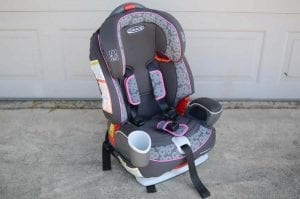Invest in the best infant car seats to protect your children while traveling. The good thing is there are various types of car seat options.

Car Seat Laws
Car Seats Safety
Car Seat Classifications
Considering the stats, a child restraint system is a piece of baby gear you’d want to have, but how to choose the best car seats? What really is an infant car seat? How distinct is a convertible car seat? What are the various kinds of car seats? Well, read on to find out what is the right car seat for your baby. Be sure to also check all our car seat-related articles here.
Infant Car Seat Type
If you’re an expecting parent, it’s essential to choose an infant seat recommended by vehicle manufacturers that allow children to ride in a rear-facing position for safety reasons, with the maximum weight limit ranging from 30-35 pounds. The rear-facing infant car seat is designed for children younger than two and typically have a rear-facing height and weight limit that must be adhered to for safety. A car bed may also be a suitable option for very young infants who need to lie flat.

Car Seat Type: Convertible
These are for rear-facing babies and a forward-facing seat for toddlers, so they should last the child until they’re at least 6-7 years old. Usually, the different kinds of car seats are designed for holding rear-facing babies for up to 40 pounds and 70 pounds front-facing. You should try to, however, leave the child to remain rear-facing for as long as you can. Don’t change it around until your child reaches this certain weight and height limit, which is about four. To make an informed decision of transitioning to the next type of car seat, consider factors such as “how much does your child weigh?” and their height, ensuring their safety during travel.

Booster Seat
After outgrowing the convertible car seat, children typically transition to a belt-positioning booster seat. After all, they can’t use the same car seat from birth to toddler years. Some best convertible car seats use a booster as well, or even just get the car lap and shoulder belt seats for securing the child while they’re in the booster. Additionally, a high-back booster seat offers support for the child’s head, while backless boosters are suitable as long as the car seat provides adequate head support. This careful selection and transition of car seats are crucial steps to ensure the child’s safety and comfort during travel.

Car Seat for 12-13-Year-Olds
You should use this type of car seat until you know your child can correctly and efficiently fit in the car seat. Some use boosters for children until they are about 12 or 13 years old, ensuring their safety and proper positioning in the particular vehicle.
Affordable Car Seats
Car Seat Installation

Car Seat Positions
That’s because it’s usually the safest, and even when they’re at ages 3 to 4, they don’t have the formative structures for adequately protecting their bodies. You should keep them in the front-facing type of car seat until they’re about 60 pounds or more or until they exceed the height limit for this too. It’s important to install different types of car seats correctly using either the lower anchors of the vehicle’s LATCH system or the vehicle’s seat belt.
Car Seat Should Fit
A car seat is crucial for many parents to ensure the safety of their children. It is essential that parents select a type of right seat that best suits their child—a car seat that will keep them safe and secure, ultimately enhancing everyone’s safety in the event of a crash. However, it’s important to note that not all car seats are created equal, and choosing the right one requires consideration of various factors. By making informed choices and ensuring that car seats fit correctly, parents play a significant role in safeguarding their children’s well-being during travel.
Car Seat Maintenance
Frequently Asked Questions (FAQs)
What Are Group 2 Type Car Seats?
Group 2 car seats are booster seats used with the vehicle’s seat belt, typically for kids aged 6-12 years old. These seats are categorized by height and weight limits, designed to keep older children safely restrained in a vehicle seat.
What Age Is A Group 1 Type Car Seat For?
Group 1 car seats are generally for children from nine months to around four and a half years old, focusing more on the child’s body weight (9-18 kg) rather than age. These car seats often come equipped with a five point harness system to secure the child and adhere to federal safety standards, ensuring optimal protection during travel.
What Car Seat Type Is For 2-Year-Olds?
The right car seat for a kid that’s two years old would be an infant car seat in the combination or forward-facing position. The facing-forward car seat can accommodate heavier children but may not be compatible with all car seats. The combination car seat has a removable harness, and this type of car seat can be used for kids weighing up to 100 pounds.
What Child Restraint System Classifications Are For 2-Year-Olds?
Can A Three-Year-Old Child Sit In The Booster Seat Types?
According to experts, three-year-olds may not be ready to sit in a booster seat, even if they fit within the guidelines set by the manufacturer. When it comes to finding the right car seat for a 3-year-old, safety and comfort are of utmost importance. Parents should consider a car seat that is specifically designed for toddlers around this age. It’s crucial to choose a car seat that provides adequate support of their developing bodies and meets the necessary safety standards. By selecting a car seat for 3-year-olds that is appropriate for their size and age and ensuring the seat belt properly secures the child, parents can ensure their child’s safety during car journeys.
What Child Restraint System Types Should My Child Be In?
Car seat types vary depending on your child’s age and the weight limit allowed. Options include infant seats for babies, a convertible seat that adjusts as your child grows, and specific car seats for older children. Each type provides various safety features for keeping your child safe during travel.
What Age Should The Child Car Seats Be Switched?
You should change your car seat when your child outgrows the height and weight limits set by the car seat manufacturer for your current model, typically between 9 to 18 months. It’s practical to have two car seats ready, such as transitioning from a rear-facing seat to a forward-facing car seat as of the manufacturer’s instructions.
How To Choose The Best Car Seats?
How Old Can A Child Use A Group 2 Car Seat?
A Group 2 car seat is for children ages 6 months up to 4 years, also depending on the child’s weight and height. If the child doesn’t fit anymore beneath the headrest in maximum positions, the child should be moved to the group 3 car seat.
What’s The Safest Child Restraint System?
In an extensive crash testing conducted by BabyGearLab, the car seat that earned the highest score in their analysis is the Graco Extend2Fit. The GracoExtend2Fit may be below average when it comes to quality. It is also not that comfortable in comparison to others at the same price, but rest assured, it is made of the best quality car seat for parents who value the safety of their infants.
Last Updated on May 11, 2023 by Rejie Salazar
DISCLAIMER (IMPORTANT): This information (including all text, images, audio, or other formats on FamilyHype.com) is not intended to be a substitute for informed professional advice, diagnosis, endorsement or treatment. You should not take any action or avoid taking action without consulting a qualified professional. Always seek the advice of your physician or other qualified health provider with any questions about medical conditions. Do not disregard professional medical advice or delay seeking advice or treatment because of something you have read here a FamilyHype.com.